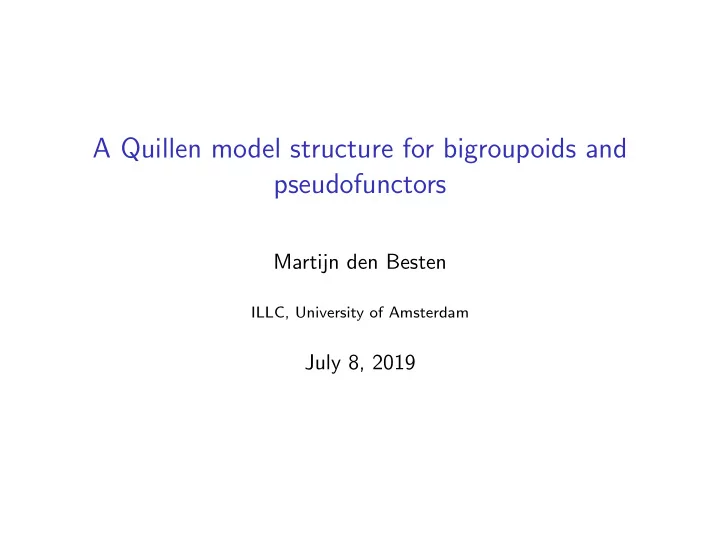

A Quillen model structure for bigroupoids and pseudofunctors Martijn den Besten ILLC, University of Amsterdam July 8, 2019 1 / 13
Some similar results Model structures exist on: Groupoids (Anderson) 2-Groupoids (Moerdijk-Svensson) 2-Categories (Lack) Bicategories (Lack) Pseudogroupoids (Lack) 2 / 13
Bigroupoids A bigroupoid consists of: 0-cells A , B , C , . . . 1-cells (between 0-cells) f A B 2-cells (between parallel 1-cells) f A B α g 3 / 13
Bigroupoids Bigroupoids have (on two levels): Identity f 1 A and A A · · 1 f f Composition gf α · · · and · · βα g f β Inversion f · · and · · α − 1 α f − 1 4 / 13
Bigroupoids The 2-cells follow the familiar laws: αα − 1 = 1 , ( γβ ) α = γ ( βα ) , α 1 = α, etc. The 1-cells follow these laws only up to a 2-cell. Example: In general: ( hg ) f � = h ( gf ) α Instead: ( hg ) f = ⇒ h ( gf ) Plus coherence laws . . . 5 / 13
Morphisms A pseudofunctor F : A − → B is structure preserving on 2-cells: F α − 1 = ( F α ) − 1 , F βα = F β F α, F 1 = 1 On 1-cells this holds only up to a 2-cell. Example: In general: Fgf � = FgFf α Instead: = Fgf ⇒ FgFf Plus coherence laws . . . Bigroupoids + pseudofunctors form a category. 6 / 13
Model structures A model structure on a category C consists of: C , F , W ⊂ Mor(C) , such that: Iso ⊂ W . W satifies 2-out-of-3. ( C , F ∩ W ) and ( C ∩ W , F ) are weak factorization systems. We do not require that C is (co)complete. 7 / 13
Model structure on bigroupoids The classes of maps are given by: ⇒ F is injective on 0-cells and locally injective on 1-cells. F ∈ C ⇐ F ∈ F ⇐ ⇒ F lifts 1-cells and 2-cells. ⇒ F is a biequivalence. F ∈ W ⇐ 8 / 13
Model structure on bigroupoids The classes of maps are given by: ⇒ F is injective on 0-cells and locally injective on 1-cells. F ∈ C ⇐ F ∈ F ⇐ ⇒ F lifts 1-cells and 2-cells. ⇒ F is a biequivalence. F ∈ W ⇐ Lifting property for F : A − → B (on 1-cells): ∃ a A ′ ∃ A b FA ′ B 8 / 13
Model structure on bigroupoids Theorem The category of bigroupoids and pseudofunctors carries a model structure, with C , F and W as defined on the previous slide. Theorem The inclusion I : 2 − Grpd − → Bigrpd, of the category of 2-groupoids and 2-functors into the category of bigroupoids and pseudofunctors is the right adjoint part of a Quillen equivalence. 9 / 13
Coherence laws For every propery (associativity, functoriality, . . . ) that needs to hold up to a 2-cell, we have a favourite witness. Example: a h , g , f ( hg ) f h ( gf ) These witnesses need to interact in a coherent way. Example: a g , 1 , f ( g 1) f g (1 f ) r g ∗ 1 f 1 g ∗ l f gf 10 / 13
Coherence theorem Theorem Every formal diagram ( ≈ a diagram consisting of favourite witnesses) commutes. Equivalently: Theorem For every morphism F : G − → H of (groupoid enriched) graphs, the induced 2-functor ∆ : Free F ( H ) − → Free 2 − Grpd ( H ), from the codomain of the free pseudofunctor on F to the free 2-groupoid on H is a biequivalence. 11 / 13
Remarks on the proof The coherence theorem is used to construct both the model structure and the Quillen equivalence. The small object argument is not used. Instead, more explicit constructions are given. Pullbacks of fibrations exist. Some constructions are made by mimicking constructions familiar from groupoids. The model structure on groupoids is used locally. 12 / 13
Future research Does there exist a model structure on bicategories + pseudofunctors? Or other similar weak higher order structures? Does it give rise to an (interesting) model of (some) type theory? 13 / 13
Recommend
More recommend